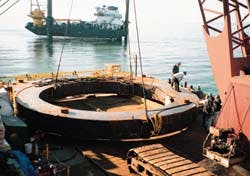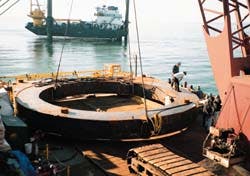Expansion-loop enclosure resolves subsea line problems
Sharon K. Rich, Alvin G. Alleyne
Intec Engineering Inc.
Houston
The enclosed expansion loop lies on deck in preparation for installation (Fig. 1).
- The "dog off" clamp (left) has been installed on the flow line (Fig. 2, [14,229 bytes]).
- The bear clamp, for pipeline-expansion loop alignment awaits installation (Fig. 3 [10,568 bytes]).
- The enclosed expansion loop is being loaded out for installation (Fig. 4 [15,105 bytes]).
Buried, subsea pipelines operating at high temperatures and pressures experience extreme compressive loads caused by the axial restraint of the soil. The high axial forces combined with imperfections in the seabed may overstress the pipeline or result in upheaval buckling.
Typically, expansion loops, or "doglegs," are installed to protect the pipeline risers from expansion and to alleviate axial forces. Buried expansion loops, however, are rendered virtually ineffective by the lateral restraint of the soil. Alternative methods to reduce expansion may increase the potential of upheaval buckling or overstressing the pipeline.
Therefore, system design must consider expansion and upheaval buckling together. Discussed here are methods of prevention and control of expansion and upheaval buckling, evaluating the impact on the overall system.
Expansion, buckling forces
A pipeline will expand or contract when temperature and pressure vary from installation conditions. Conditions during construction, therefore, become the reference temperature and pressure. For present purposes, discussion will be limited to expansion, but similar issues may require addressing for contraction.As the pipeline expands, it will follow the path of least resistance, which leads directly to the risers to the platform.
If the lower riser span is insufficiently flexible to absorb expansion within the permissible stress limit, expansion loops are typically placed just before each riser. When the loops do not function properly, as when buried, they overstress at the first bend experiencing the pipeline expansion.
The several methods readily available to reduce the expansion in the pipeline result in build-up of axial forces in the pipeline and lead to upheaval buckling, a mode of failure in trenched and buried pipelines. Pipelines resting on the seabed may also buckle but tend to buckle laterally where there is insignificant resistance.
Upheaval buckling results from the axial force generated from the expanding pipeline combined with an uneven trench bottom which results from the trenching process, undulations in the seabed, a rock formation, or an area of denser soil. Trench unevenness is generally referred to as an "imperfection."
Axial force and imperfection are related. In general terms, the more uneven the trench profile, the lower the axial force required to produce an upheaval buckle.
Methods to control expansion and upheaval buckling, discussed presently, were investigated for the design of a high pressure and temperature, buried sour gas flow line offshore in Mobile Bay, Ala., for a major operator.
Controlling expansion
There are several conventional methods used to handle expansion which, along with some unconventional methods, were investigated and include the following:- Anchor flanges and concrete and/or rough fusion-bonded epoxy (FBE) coatings each performs the same function of increasing the friction, thus reducing or eliminating expansion in the pipeline. This increase in friction, however, results in the build-up of axial forces in the pipeline contributing to increased risk of upheaval buckling.
- Cold springing the riser has proven successful for many pipelines. Cold springing prestresses the riser during construction, resulting in splitting the difference between the prestress and the expansion loads to be encountered during operation. This allows the riser to accommodate larger amounts of expansion. Cold springing allows for the natural relief of the pipeline stresses through the riser. Even allowing for cold springing, the middle of the pipeline may be anchored because of friction and experience the maximum axial force possibly resulting in upheaval buckling.
- The riser bend may be reinforced with a brace, distributing the forces over more of the riser. Reinforcing is limited in the amount of expansion it may accommodate, however, and does not alleviate the forces in the middle of the pipeline.
- Pipe-in-pipe construction is an option that has been utilized when other solutions fail. It is costly because the product carrier pipe is inside a jacket pipe normally two sizes larger. The two pipes are mechanically connected with bulkheads that transfer the loads from the carrier pipe to the jacket pipe.
While the carrier pipe expands, the jacket pipe resists the expansion loads. The spacing and size of the bulkheads are determined to eliminate buckling of the carrier pipe within the jacket pipe to minimize installation expense.
The structural design of the pipe-in-pipe virtually eliminates expansion and the potential of upheaval buckling if the system is properly designed. The cost of extra materials, however, and the lengthy process of fabricating the pipe-in-pipe warrant investigation of other options.
- Expansion loops and doglegs serve the purpose of acting as a spring to accommodate expansion at the risers. Several expansion loop and dogleg configurations were investigated for the installation in Mobile Bay, including conventional U-loops of various dimensions, and various angles for the doglegs.
It was found that buried expansion loops and doglegs experience high lateral resistance that in turn creates localized high stresses at the first bend. Only a short length of the expansion loop was buried, with minimal effectiveness.
To illustrate the relative effectiveness, it was found that a conventional expansion loop 40 x 40 ft was effective only over 4 ft when buried and had a much-reduced capacity for expansion. Similar to other methods, the expansion loop placed at the riser would not relieve the stresses in the middle of the pipeline.
- A zig-zag shaped pipeline has been employed to accommodate expansion and relieve axial forces throughout the pipeline.1 The pipe joints were bent in a zig-zag configuration and double jointed for installation. Each joint accommodated some of the expansion and relieved some of the axial force.
Although this solution has applications, the additional cost and concerns of fabrication and installation limit its applicability.
- Snaking the pipeline during installation appeared promising in principal. The pipeline would act as its own spring throughout the length, accommodating the expansion and alleviating the axial forces.
Snaking the pipeline requires additional pipe which contributes to more costs and more expansion at the ends.
Controlling upheaval buckling
Upheaval buckling may be controlled or eliminated with rock dump or additional burial. Each method applies additional weight on the pipeline, preventing upward movement.The rock dump may be applied where needed, usually after a buckle has occurred, or over the entire pipeline. The additional weight on the pipeline also reduces expansion over the length of the pipeline, thus reducing stress at the risers.
This simple solution is, however, costly and does not address the entire problem.
While the pipeline may be held below the seabed by the weight on it, it may be overstressed. Most codes allow the pipeline to experience predictable and controllable overstress within a strain limitation.
Although this option should be taken advantage of, it still may not be enough for all cases. Small-diameter pipelines are particularly susceptible to upheaval buckling and overstressing and require additional consideration.
Design process
Investigation of these options determined that expansion loops over the length of the pipeline must be employed to protect the risers and reduce the axial force within the middle of the pipeline. This conclusion led to two options: using many small buried loops or finding a way to have several larger loops work as if they were not buried.Because it was impractical to install many small loops, methods of preventing soil from accumulating around the expansion loop when buried was investigated.
Research of methods to isolate the loops from the soil determined that the most likely commercially available option called for concrete "dog houses." These are used to protect pipelines and expansion loops from dropped objects.
But there was no existing configuration of the dog houses suitable for burial. And fabrication of custom concrete housings was expensive and heavy for construction. Therefore, it was concluded that fabrication of a steel enclosure was the most likely solution.
With a direction for the system design identified, the expansion-loop design was optimized. Because of the weight of the steel enclosure added to the expansion loop, it was desirable to minimize the size and quantity of the expansion loops.
Expansion-loop shapes investigated included U, omega, helix, and double helix. A finite element analysis (FEA) model was developed for each shape.
The helix was found the most efficient by far. The double helix would provide additional benefit but almost doubled the material costs and weight. The resulting enclosure would also have protruded from the natural seabed or required additional burial.
The initial size, quantity, and placement of the expansion loops were determined with a mathematical model based on internal design guidelines using the ultimate soil friction2 for buried pipelines. From the mathematical model, the anchor locations and expansion could be determined, resulting in the placement and sizing of the expansion loops.
The optimum spacing would protect the risers from overstressing and minimize the axial forces within the pipeline, thus reducing potential for upheaval buckling.
The lower the axial forces could be made, the larger the imperfection heights that could be allowed during construction. The axial forces must be reduced to a level to allow achievable imperfection heights during construction.
The upheaval buckling potential and corresponding stress levels were checked throughout the design with a mathematical model.3 This constant verification of the design aided in the optimization of the system design.
FEA model development
An FEA model developed for the design used industry-recognized software. To speed investigation of many options, a program for the model was developed with the system nodal configuration, element definition, and temperature gradient calculated in a spreadsheet to be read into the program.The temperature gradient was calculated based on the results of the thermal hydraulic analysis. This enabled each node to have a unique temperature, reducing potentially unnecessary conservatism. Most of the input values were calculated in the program to minimize input changes from case to case, thus reducing entry and checking time, and potential for error.
The soil was modeled in detail. The soil was represented axially and laterally along the length of the pipeline.
Nonlinear springs were used to represent the soil's resistance to movement. The lateral resistance for the riser bends was modeled separately at each node to allow for the soil's pressure variance with burial depth.
The results of the FEA model proved the mathematical model accurate. The initial placement and size of the expansion loops proved to be almost perfectly optimized on the first configuration of the FEA model. The mathematical model proved to be slightly conservative and thus a useful preliminary design tool.
Design optimization had to consider varying soil, start-up, and operating conditions. The final configuration had to satisfy all conditions. The mathematical model was used to reduce FEA model configuration changes to achieve faster optimization.
The spacing of the expansion loops considered the joint lengths to allow for ease of placement during installation: a joint spacing, for example, similar to that specified for anodes.
When the optimized configuration was determined from the mathematical model, the system was verified with the FEA model to meet all conditions. With the exception of further design scenarios, the configuration required no further refinement from that proposed based on the mathematical model.
Temperature
considerations
Care must be taken when establishing the cases to be investigated with respect to temperature. As previously mentioned, the temperature at which the pipeline was installed is the reference temperature for all further expansion. This reference temperature is often confused with ambient temperatures used for thermal hydraulic analysis. This analysis typically used the lowest ambient temperature to be experienced during operation as the worst case for hydrate formation in gas lines and wax build-up in oil lines.
It is not the worst case for expansion, however. That case is the highest flow rate, at the highest inlet temperature and pressure, and at the highest ambient temperature. It is likely that the reference temperature for expansion will be different from the ambient temperature for the thermal hydraulic analysis.
The temperature interaction may be illustrated with the case of a winter or spring installation, establishing a low reference temperature, then later operating the pipeline in the summer, with a high ambient temperature.
This scenario represents the worst case for expansion. It can be seen that it may be beneficial to install high-temperature pipelines in the summer to minimize the difference between the reference and operating temperatures.
Enclosure design
With the size requirements for the expansion loops established, only design of the enclosure remained. Throughout the system-optimization process, the expansion-loop design was considered based on weight, fabrication, ground shipping limitations, and installation.With these considerations already investigated, the enclosure design was left to consider uninhibited expansion-loop movement, structural integrity during handling and installation, ease of fabrication, lifting methods, and ease of burial.
From these considerations, the design was developed with the use of industry-recognized structural software.
The major concerns in the structural design of the enclosure were:
- To design the shell plating to resist the soil pressure loads in the buried condition
- To ensure the shell was adequate for differential hydrostatic pressure during the flooding operation, for retrieval at the end of life, or unplanned retrieval during the installation operation
- To avoid high shock loads in the lift slings.
If upward hydrodynamic acceleration resulted in forces greater than the submerged weight, the slings would go slack and the structure would free-fall during the downward acceleration.
The main design features of the enclosure include the following:
- Teflon-padded supports above and below the expansion loop to provide for free movement
- Monel overlay on the expansion loop at the entrance and exit of the enclosure for abrasion resistance
- Baffles to minimize soil that enters the enclosure from accumulating near the expansion loop
- Stiffeners to reduce plate thickness
- Large and numerous vents with caps for rapid flooding
- Open center to minimize weight and aid in burial
- Installation collars around the pipe on the inside of the enclosure to resist installation tension on the expansion loop.
Installation
Among installation options considered were the following:- Installing the expansion loop in the pipe string on the barge
- Picking up the pipeline after installation, cutting out a length of pipe, and installing the expansion loop
- Using a spool piece flanged in the pipe string during installation and picking up the pipeline after installation to replace the spool piece with the expansion loop.
The second vessel was to be a jack up to provide stability for the expansion loop during interface with the surf. The laybarge would pass the expansion loop to the jack up and continue laying away as the jack up lowers the expansion loop to the seabed.
The second option was selected as the alternate method. Expansion-loop installation requires calmer weather than normal laying. Therefore, if weather were delaying installation but normal lay could occur, the laybarge could later come back and install the expansion loops.
If this option were employed, consideration of any gain in the pipeline during the lifting would have to be compensated for by placing the expansion loop away from the original position of the pipeline. If slack were taken up by the expansion loop, its effectiveness would be diminished or eliminated.
The third option was not considered viable because of the high pressure, sour gas. Potential leaking of the flange was an unacceptable risk. In other cases, this may be the most efficient method of installation. As with the second option, gain in the pipe must be considered and accounted for.
Construction was carried out in December 1997 through February 1998. Installation procedures were carefully planned to minimize delay.
The procedure for installing the enclosed expansion loops involved the following steps:
- Using a "dog off" clamp to secure the pipeline and release the tensioners (Fig. 2)
- Cutting the pipe and pushing the cut pipe back up the welding stall
- Positioning the enclosure in the pipe string
- Lining up the pipeline and expansion loop with a bear clamp for welding (Fig. 3)
- Once the pipeline and expansion loop were secured, removing the clamp and finishing the weld
- Repeating Steps 4 and 5 for the other side of the expansion loop
- Passing the enclosure from the barge crane to the jack up crane
- Pulling the barge forward while lowering the enclosure with the jack up (Figs. 4 and 5).
The final task for construction, burying the enclosures, was performed with hand jetting. It went well, with the exception of weather downtime.
References
- Lanan, G.A., and Barry, D.W., "Mobile Bay Fairway Field Flowline Project," 24th Annual Offshore Technology Conference, May 1992, Houston.
- Audibert, J.M.E., et al., "Design of Pipelines to Resist Seafloor Instabilities and hydrodynamic Forces," ASME Energy Technology Conference and Exhibition, Houston, November 1978.
- Palmer, A.C., et al., "Design of Submarine Pipelines Against Upheaval Buckling," 22nd Annual Offshore Technology Conference, May 1990, Houston.
The Authors
Sharon K. Rich is a project engineer at Intec Engineering Inc., Houston, with 6 years' experience in international offshore pipeline projects for the oil and gas industry. Rich holds a BS in marine engineering from Texas A&M University and is a member of the Society for Naval Architects & Marine Engineers.
Alvin G. Alleyne is a senior project manager at Intec, currently on assignment to Intec Engineering BV, Leiden. He has 33 years' experience in international offshore design and construction.Alleyne holds a BS from the University of the West Indies, Trinidad, an MBA from the University of Houston, and is a registered professional engineer in Texas.
Copyright 1998 Oil & Gas Journal. All Rights Reserved.



